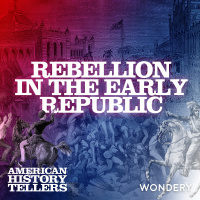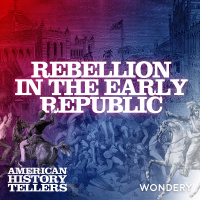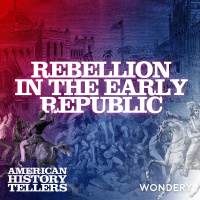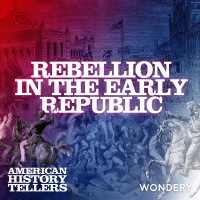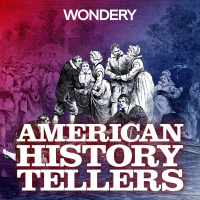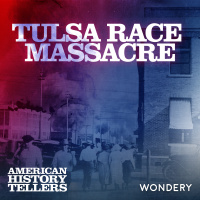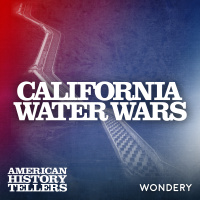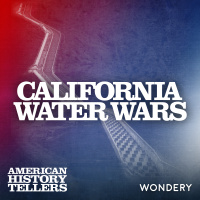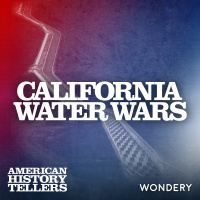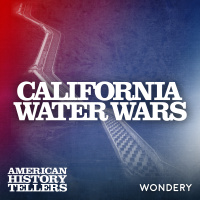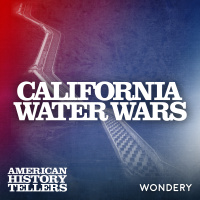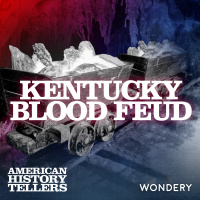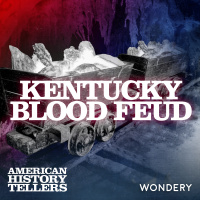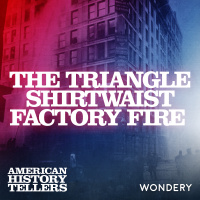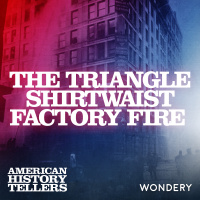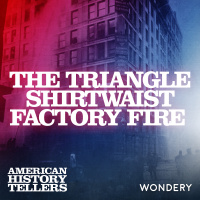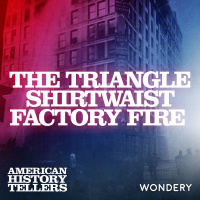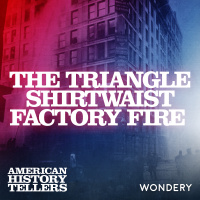Sinopsis
The words you speak. The ideas you share. The freedoms you defend. Every part of your life can be traced to our shared history, but how well do you really know the stories that made America? We’ll take you to the events, the times and the people that shaped our nation and Americans. And we’ll show you how our history affected them, their families and affects you today. Hosted by Lindsay Graham. From Wondery, the network behind Tides Of History, History Unplugged, Fall Of Rome and Dirty John.
Episodios
-
Rebellion in the Early Republic - Crisis in the West | 4
08/04/2020 Duración: 37minIn 1794, anti-government protests grew into an all-out rebellion, and President Washington faced his first major test of federal authority. Some 7,000 armed Westerners marched on Pittsburgh and threatened its residents. Violent resistance to the whiskey tax soon spread from western Pennsylvania to Kentucky, Maryland, Virginia, North Carolina, and Georgia.Washington and his cabinet held tense meetings to debate a response to the so-called Whiskey Rebellion. The country’s first president was determined to act quickly and decisively, despite divisions among his close advisers. Nothing less than the sovereignty of the young nation was at stake.Support us by supporting our sponsors!See Privacy Policy at https://art19.com/privacy and California Privacy Notice at https://art19.com/privacy#do-not-sell-my-info.
-
Rebellion in the Early Republic - The Whiskey Rebellion | 3
01/04/2020 Duración: 42minOnly a few years after Shays’ Rebellion was suppressed, a new revolt broke out in western Pennsylvania. Anti-government resentment had been growing on the frontier for years. Then in 1791, the U.S. government handed down a tax on domestic spirits. It became known as the Whiskey Tax. Many western farmers and distillers, already struggling under harsh conditions, refused to pay the tax and rose up in defiance. Armed gangs ambushed tax collectors—and anyone who supported them.As resistance spread, authorities struggled to suppress the violence. Then, in the summer of 1794, hundreds of rebels went to battle against U.S. Army troops at Bower Hill, the mountaintop mansion of a wealthy tax collector. The rebels burned the manor to the ground and a popular rebel leader was shot dead, inflaming tensions.The federal government had an unprecedented crisis on its hands.Support us by supporting our sponsors!See Privacy Policy at https://art19.com/privacy and California Privacy Notice at https://art19.com/privacy#do-not-se
-
Rebellion in the Early Republic - A Constitution Shaped by Revolt | 2
25/03/2020 Duración: 40minTensions reached a climax in the freezing winter of 1787, as Daniel Shays and 1,500 rebel soldiers stormed the federal arsenal in Springfield, Massachusetts. The rebels hoped to seize arms and ammunition and burn Boston to the ground. What they didn’t know was that a government army awaited them, setting off a dogged chase in the winter snow that lasted weeks.The farmers’ revolt reverberated far beyond Massachusetts. Shays’s Rebellion stunned America’s political elite, even drawing a horrified George Washington out of retirement to return to public life. The uprising helped convince the nation’s power brokers to throw out the Articles of Confederation and devise a new Constitution. They were determined to create a strong federal government, one that they hoped could withstand domestic rebellion. But their efforts sparked a bitter dispute about the role of government in the new Republic.Support us by supporting our sponsors!See Privacy Policy at https://art19.com/privacy and California Privacy Notice at https:
-
Rebellion in the Early Republic - Farmer Uprising | 1
18/03/2020 Duración: 37minThe dust had barely settled on the American Revolution when new unrest erupted in western Massachusetts. Thousands of farmers and laborers rose up in protest against unjust taxes and a state government that seemed as oppressive as the British Crown. When their demands for reform fell on deaf ears, the protesters grew more desperate. They took up muskets, swords, and clubs and formed blockades to shut down local courthouses. The growing revolt became known as Shays’s Rebellion.Boston’s government and merchant elites were horrified by the upheaval, fearing the specter of mob rule. They saw the uprising as democracy run amok, and moved to raise an army against the rebels. The showdown would test the very legacy of the American Revolution.Support us by supporting our sponsors!See Privacy Policy at https://art19.com/privacy and California Privacy Notice at https://art19.com/privacy#do-not-sell-my-info.
-
Encore: What We Learned from Fighting the Spanish Flu | 1
11/03/2020 Duración: 47minIn light of growing concerns about the coronavirus, we’re revisiting an episode we ran last spring. One hundred years ago, the Spanish flu pandemic forever reshaped the way the United States responds to public health crises. At a time when people around the world were already dying on an unprecedented scale due to World War I, Spanish flu devastated American cities, killing more than 675,000 people in the U.S. alone. The virus had a profound effect on impact on medicine, politics, and the media, revealing deep flaws in the U.S. government’s ability to respond to such a disaster. But it would also lead to the creation of new public health institutions that still endure today, and it would help usher in a new era of global collaboration in the medical community.For more information about the coronavirus, visit the following websites: Centers for Disease Control and Prevention:https://www.cdc.gov/coronavirus/2019-ncov/index.html World Health Organization:https://www.who.int/emergencies/disea
-
Tulsa Race Massacre Update: Excavating Mass Graves | 7
04/03/2020 Duración: 37minNew archaeological evidence suggests mass graves holding the remains of victims of the Tulsa Race Massacre may exist on two sites in Tulsa. And now scientists plan to excavate portions of those sites to try and uncover the truth. Residents for years had asked the city to take similar steps but until now it hasn’t happened. On this episode we get an update on these developments from Hannibal B. Johnson, an attorney and historian who has written several books on the Massacre. He joins us from Tulsa to talk about what this excavation could uncover and what it means when a community reckons with the darkest part of its history.Support us by supporting our sponsors!See Privacy Policy at https://art19.com/privacy and California Privacy Notice at https://art19.com/privacy#do-not-sell-my-info.
-
California Water Wars - Los Angeles and the Future of Water | 6
26/02/2020 Duración: 40minUCLA environmental historian Jon Christensen discusses Los Angeles, its never-quenched thirst for water, and what that means for the future.Support us by supporting our sponsors!See Privacy Policy at https://art19.com/privacy and California Privacy Notice at https://art19.com/privacy#do-not-sell-my-info.
-
California Water Wars - Collapse | 5
19/02/2020 Duración: 37minWith the failure of the Watterson brothers’ banks, the Owens Valley community was forced to abandon its fight for water rights against the city of Los Angeles. William Mulholland, the Los Angeles water department superintendent, could finally breathe a little easier. The city now had full control over its water supply for the foreseeable future. But he would discover that some things can’t be foreseen. Construction had finished in 1926 on the last of the nineteen dams that lined the aqueduct. Standing 200 feet tall, the St. Francis dam held back billions of gallons of water. But by spring of 1928, troubling cracks were beginning to appear in the dam’s surface. The events of March 12, 1928, would lead not only to a terrible catastrophe, but would forever change the way the citizens of Los Angeles thought about William Mulholland -- the man who brought them water.Support us by supporting our sponsors!See Privacy Policy at https://art19.com/privacy and California Privacy Notice at https://art19.com/privacy#
-
California Water Wars - We Who Are About to Die Salute You | 4
12/02/2020 Duración: 37minAfter years of letting their water be used by the city of Los Angeles, the farmers and ranchers of the Owens River Valley decided to fight back. What would come to be known as California’s Civil War would mark the 1920s with a series of attacks and reprisals between the valley and the city two hundred miles south. With Los Angeles sending agents north to buy more land and secure yet more water rights, valley residents decided to take matters into their own hands. After several attacks damaged portions of the aqueduct, causing water to stream uselessly down into the valley, the city realized it had a desperate problem on their hands.But all was not well with the citizens of the valley, as a long-running family feud threatens to tear apart the Owens Valley community from within.Support us by supporting our sponsors!See Privacy Policy at https://art19.com/privacy and California Privacy Notice at https://art19.com/privacy#do-not-sell-my-info.
-
California Water Wars - “There It Is—Take It” | 3
05/02/2020 Duración: 37minBy 1912, the Los Angeles aqueduct project was nearing completion. But as it approached the finish line, fears were growing among the public of a vast conspiracy, fanned by socialist Job Harriman. With the formation of the Aqueduct Investigation Board, engineer William Mulholland found his methods and his purpose suddenly under a microscope. Land deals from nearly a decade ago would threaten to derail the entire project, just a year shy of its completion.As the roaring Twenties loomed, Los Angeles would grow exponentially. But far north, in Inyo County, the ranchers whose water had been taken from them were gearing up for the first of many retaliations.Support us by supporting our sponsors!See Privacy Policy at https://art19.com/privacy and California Privacy Notice at https://art19.com/privacy#do-not-sell-my-info.
-
California Water Wars - Building the Dream | 2
29/01/2020 Duración: 37minBy 1907, the city of Los Angeles had found a solution to its water problem. Two hundred miles north in the Owens River Valley was a never-ending source of water. Los Angeles Water Department superintendent William Mulholland set about constructing one of the largest public works projects the state of California has ever seen. But first, he would have to convince the voters of Los Angeles to approve the project. And then, he would have to build it himself. For five years construction crews filed into the desert, building a massive aqueduct system that would ferry the water all the way to the thirsty city. Along the way, Mulholland would encounter problems with bureaucrats, bad food, and dynamite. With the project hurtling towards completion, serious doubts would be raised about graft and self-interest. Was the Los Angeles aqueduct really just about water? Or was it set to make a handful of rich men even richer?Support us by supporting our sponsors!See Privacy Policy at https://art19.com/privacy and Califo
-
California Water Wars - A River in the Desert | 1
22/01/2020 Duración: 36minBy the turn of the twentieth century, Los Angeles had grown from a dusty, crime-ridden pueblo into a thriving metropolis. The only problem was that it was growing too fast. With no consistently reliable water source and a desert climate leading to a decade-long drought, the city would have to begin looking elsewhere.In the Owens River Valley, over two hundred miles north of the city, a vast, rushing river, fed by Sierra mountain snow, lay the solution. But how to get the water from the Owens Valley to Los Angeles? City water superintendent William Mulholland and former Los Angeles mayor Fred Eaton devised a breathtakingly simple plan: they would build an aqueduct. As Mulholland began sketching out an engineering vision for the project, Eaton secretly purchased land rights in the Owens Valley.But Eaton’s methods left many valley residents bewildered and angry, setting up a decades-long battle for survival that would pit a metropolis against a small ranching community.Support us by supporting our sponsors!See P
-
Kentucky Blood Feud - The Revenge of Bad Tom Baker | 2
18/12/2019 Duración: 37minThe Civil War forced the warring families of Clay County into an uneasy truce. The Garrards, Whites, Howards, and Bakers found themselves allied as they fought for the Union. But the war brought new challenges: the Northern army destroyed Clay County’s salt mines in order to keep them out of the hands of the South, and the Emancipation Proclamation brought an end to slavery, which had helped make salt mining so profitable.The Garrards and the Whites were so rich that they were able to withstand these pressures on their businesses. But the poorer Bakers and the Howards soon found themselves fighting over scraps of land and timber. And in 1898, a business dispute led “Bad Tom” Baker and “Big Jim” Howard to assassinate members of each other’s families, starting a wave of killings and arsons so bloody they would reshape the state.Support us by supporting our sponsors!See Privacy Policy at https://art19.com/privacy and California Privacy Notice at https://art19.com/privacy#do-not-sell-my-info.
-
Kentucky Blood Feud - The Murder of Daniel Bates | 1
11/12/2019 Duración: 34minThe longest and bloodiest feud in American history erupted in the 1840s in Clay County, Kentucky — where it raged for nearly a century and ultimately claimed more than 150 lives. The Clay County War, also known as the Baker-Howard Feud, pitted four families against each other: the powerful Garrads and Whites, who assembled vast wealth mining salt, and the less influential Bakers and Howards. In time, the Garrards would align with the Bakers, and the Whites with the Howards. At first, the families got along, cooperating in the back-breaking work involved with extracting salt in the Appalachian region. But as the economy collapsed and new technologies led to new competition from the outside, the families would find themselves increasingly competing for survival — and a single act of violence would be enough to spark a conflict that spanned generations. Support us by supporting our sponsors!See Privacy Policy at https://art19.com/privacy and California Privacy Notice at https://art19.com/privacy#do-not
-
The Legacy of The Triangle Fire | 5
20/11/2019 Duración: 39minIn September 2019 Democratic Senator and presidential candidate Elizabeth Warren invoked the memory of the Triangle Shirtwaist Factory Fire at a campaign rally just a few blocks from the site of fire in Manhattan. It was a powerful reminder of just how deep the legacy of the disaster runs. Organized labor and workplace safety have come a long way since the fire but after years of political opposition, unions and worker rights are on the decline. In the U.S., unions represent 6.4 percent of private-sector workers and just 10.5 percent of workers overall. That’s the lowest percentage in more than a century, and down from 35 percent in the 1950s. That's according to Steven Greenhouse, author of the new book Beaten Down, Worked Up: The Past, Present, and Future of American Labor. Greenhouse joins us to talk about the state of labor in America today and why after years of decline, labor is starting to gain steam.Support us by supporting our sponsors!See Privacy Policy at https://art19.com/privacy and California Pr
-
The Triangle Shirtwaist Factory Fire - In America They Don’t Let You Burn | 4
13/11/2019 Duración: 41minIn the wake of the biggest workplace catastrophe in the city of New York, the survivors of the Triangle fire and the families of the victims could only watch from the sidelines as the case against the Triangle bosses went to trial. The 146 deaths resulting from the fire had been sifted through the state’s legal machine and condensed into a single woman: a 24-year-old sewing machine operator named Margaret Schwartz. In December 1911, the general sessions court presided over by Judge Thomas Crain heard the People of New York vs. Max Blanck and Isaac Harris. The prosecution had a strong piece of physical evidence and a compelling witness. But Harris and Blanck had a lawyer whose courtroom rhetoric might get his clients off scot-free. If you enjoyed American History Tellers, be sure to check out Lindsay Graham’s other shows, American Scandal and American Elections: Wicked Game. Support us by supporting our sponsors!See Privacy Policy at https://art19.com/privacy and California Privacy Notice at htt
-
The Triangle Shirtwaist Factory Fire - Sixteen Minutes | 3
06/11/2019 Duración: 37minTwo years after the labor strikes that shook the city of New York, the workers of Triangle factory returned to better wages and lower hours. But when a fire broke out near closing time on a Saturday afternoon, these same workers found themselves swept up in a catastrophe. Some would escape, but many would not. In the weeks that followed, a city mourned and began to wrestle with questions of responsibility. Where did the blame for the tragedy lie? With the city? With the factory owners? Or with the workers themselves? Support us by supporting our sponsors!See Privacy Policy at https://art19.com/privacy and California Privacy Notice at https://art19.com/privacy#do-not-sell-my-info.
-
The Triangle Shirtwaist Factory Fire - Revolt of the Girls | 2
30/10/2019 Duración: 39minInspired by the labor strikes at Triangle and other factories in Lower Manhattan, more than 30,000 garment workers took to the streets of New York in protest in late 1909. For the first time, an industry of women sought not to just halt production at one factory — they wanted to put the brakes on an entire trade. With over four hundred garment factories shut down, factory owners banded together with police and the courts to fight the striking workers. But as the labor movement attracted new high-society allies, internal politics began to fracture the labor movement, threatening to derail the entire cause.Support us by supporting our sponsors!See Privacy Policy at https://art19.com/privacy and California Privacy Notice at https://art19.com/privacy#do-not-sell-my-info.
-
The Triangle Shirtwaist Factory Fire - Wildcat | 1
23/10/2019 Duración: 39minOn March 25, 1911, a fire broke out at the Triangle Shirtwaist Factory in Manhattan, claiming the lives of 146 garment workers — mostly women and girls. It was one of the deadliest workplace disasters in American history. Caused by a combination of carelessness and poor safety measures, the fire eventually set off a wave of workplace reforms that changed industry in America and sent New York party politics in a totally different direction.But in the years before the fire, the workers of the Triangle factory were focused on a different issue — advocating for higher pay. Facing long hours and unsympathetic bosses unwilling to implement change, the women decided they had only one option left. It was time to go on strike.Support us by supporting our sponsors!See Privacy Policy at https://art19.com/privacy and California Privacy Notice at https://art19.com/privacy#do-not-sell-my-info.
-
Dutch Manhattan - The Dutch Influence Today | 7
16/10/2019 Duración: 50minNew York City was founded on the Dutch principles of tolerance and capitalism, both of which were new ideas at the time. But much of the city's early history was lost until the 1970s, when a renewed interest in the Dutch period led to the founding of the New Netherland Center. Here, thousands of previously untranslated records shed new light on this crucial moment in Gotham’s history. Our guest today is Greg Young, who co-hosts the Bowery Boys, a popular podcast about all things New York City history. Young visited the New Netherland Center, and he joins us to share what he found there and where Dutch influence can still be seen in New York today.Support us by supporting our sponsors!See Privacy Policy at https://art19.com/privacy and California Privacy Notice at https://art19.com/privacy#do-not-sell-my-info.

